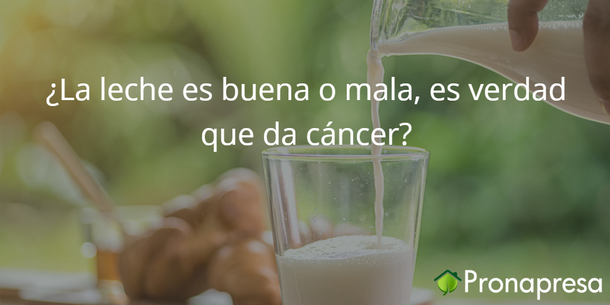First of all, we must take into account that milk is an exclusive food for the offspring of mammalian animals. Milk contains a sugar called lactose (about 5g per glass) that does not exist in any other food. Animals produce the enzyme lactase in their intestines, which is necessary to digest lactose while they are suckling and which disappears from the intestine after weaning. The same thing happens to human beings, but a small part of the population (approximately 30%, especially Europeans) harbors in their genome a rare mutation of a gene, which allows the persistence of the enzyme lactase in the intestine, after weaning They are the privileged ones who can digest milk, the rest are those who are lactose intolerant; If they consume dairy products they can have serious intestinal problems.
Milk contains several proteins whose mission is to provide nutrition and defenses to the newborn. Cow's milk contains about 3.5g of protein per glass of milk. The most abundant protein is casein (Casein is a phosphoprotein present in milk and some of its derivatives. In milk, it is associated with calcium, forming aggregates that are called casein micelles). For adults, these milk proteins are digested in the intestine giving amino acids that mix with the amino acids from other foods. Because some proteins in cow's milk are different from those in human milk, some children may have allergic reactions when they start consuming it. This allergy disappears in half of children by one year of age and in 90% by five years of age. Do not forget that casein is found as an additive in many foods, for example in cold cuts.
Milk has a nutrient composition that is most suitable for the needs of the lactating calf. Its characteristics include its high content of saturated fats (between 3 and 6g per glass), especially low molecular weight (they are absorbed very easily in the intestine), necessary to provide the lactating animal's body with the energy it needs to develop. . But these fats are very harmful to health since they promote atherosclerosis and cardiovascular disease, firstly because they are saturated, secondly because they are consumed in large quantities, several times a day, every day of life. This is the reason why half of the shelves in the dairy section of the hypermarket are dedicated to lactose-free milk.
Another interesting aspect that should be clarified is that of calcium, vitamin D and bone. In recent times, the mixture of two phenomena such as the aging of the population and the rampant sedentary lifestyle that invades us is the cause of the increase in osteoporosis, which occurs mainly in women, starting with menopause. Prevention is based on three measures that must be taken together: ingestion of foods rich in calcium, which is the mineral component of bone, acquisition (through the sun and food) of sufficient vitamin D, which stimulates the intestinal absorption of calcium and physical exercise, which favors the deposit of calcium in the bone. Milk is the most effective way to administer the calcium we need. A glass of milk, a portion of cheese and a yogurt a day is enough. The intestine only absorbs the calcium we need, since if it absorbed everything we ingest we would end up turning into stone statues. Those people who cannot consume dairy products due to lactose intolerance should not worry because almost all foods contain calcium. We highlight canned anchovies, which have much more calcium than milk. Some foods have the same calcium content as milk, such as canned cockles, chickpeas, sea bass, spinach or shrimp.
Lately the issue of milk and health has become even more complicated. At different levels ranging from private blogs on the internet to consultations, consuming milk cures breast cancer in which it is proclaimed that the relationship between breast cancer and milk consumption is of such magnitude that they recommend that all women stop consuming dairy products. This type of information without scientific basis causes a lot of harm, as it instills false expectations in women who are fighting the disease. On the contrary, if you consult on the Internet the page dedicated to breast cancer and its treatment, published by the United States Institutes of Health, one of the most prestigious institutions in the world, it says nothing about this supposed carcinogenic effect of milk. . Furthermore, in 2010 two studies on the subject were published. One of the studies measured the milk and dairy consumption of 64,900 Norwegian women between 1996 and 2006. During the study period, almost 1,500 breast cancers were diagnosed in the group. The conclusion is that dairy consumption was not related to the risk of breast cancer. Similar results are presented in another study, this time carried out on 3,600 French women, who developed 92 breast cancers.
In conclusion, milk and dairy products are good, very complete foods that should be consumed in moderation, without excesses, and should be avoided by people with lactose intolerance.
Share our posts, also like our Facebook, follow us to stay up to date with information like this.
PRONAPRESA
"Because prevention is better than cure"

